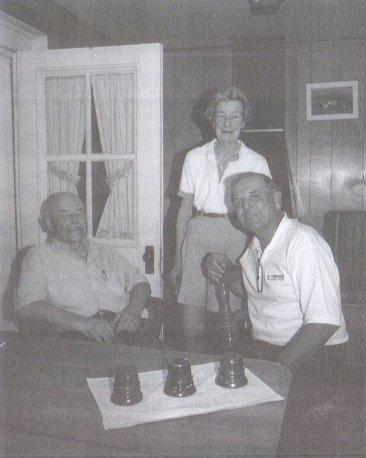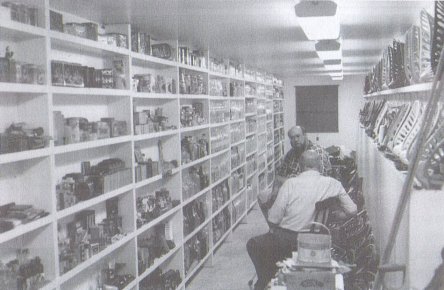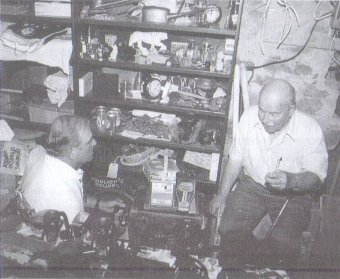A tribute to the life of Douglas G. Henderson
Reprinted from "Crown Jewels of the Wire", February 2001, page 4
Last night as I was looking out the window into the dark, I watched the mist
creep around the house. The fireflies danced in the bushes and the drops of rain
tap, tap, tapped off the roof. "This is Dad," I thought. "This is
what he loved. This is where he will forever live."
For 87 years he quietly
worked the land, fixed the never-ending list of broken machinery and presided at
the head of our old oak table. (And Heaven help anyone if they actually tried to
sit in his big chair for very long. It was always amusing if someone did. If Dad
suddenly walked into the kitchen, the culprit, without missing a beat in the
conversation would get up a move to another chair. It was a perfectly
orchestrated dance). His place. His spot. And richly deserved.

Doug Henderson, his wife Jean, and Doug MacGillvary discuss
the
"Henderson Hats", Canadian porcelain threadless insulators.
Douglas Henderson was born at home in Montreal in 1913. His father, our
grandfather, had come direct from Aberdeen, Scotland and passed on to Dad a
slight Scottish brogue, a very warm heart, and capable, gentle hands.
We've seen
those hands wrestle a bull to the wall or softly birth a baby lamb. He could
rebuild an engine or gently remove a tiny bee stinger from the arm of a sobbing
3-year old. How hands at least twice the size of mine could perform even the
most delicate of tasks was part of the magic that was my father.
It was this
magic that drew children to him and he often spent many hours letting his very
young children and grandchildren tag along with him picking butternuts, building
things or sitting on his lap on the tractor.
When I was in Grade One and the
same age my daughter is now, Dad invited my school class to our farm for a
school trip. He loaded us all onto a hay wagon and took us back to an old gravel
pit where he promised us there was an old diamond mine. When the kids arrived
the earth was glistening with hundreds of aluminum foil wrapped lollipops that
he had planted in the sand earlier in the morning. We were handed little bags
and dug for "diamonds" all day. An old gravel pit suddenly turned
magical.
After Montreal, Dad lived in Three Rivers and then attended MacDonald
College. It was there he met a feisty woman from the Maritimes. The combination
of our father's gentle intellectualism and Jean Oland's gregarious magnetism
proved a perfect match. It was Jean who brought out the wee Scottish imp in
Doug. Needless to say, he married Jean in St. John, New Brunswick in 1943 and
they remained life partners for 57 years. He used to tell me, "I would just
look at her and wonder how I had found such a beautiful dame."
In 1936 Doug
had lovingly picked out the Ontario farm where he would spend his entire life.
His love of nature had gained him both a diploma in Horticulture and his Degree
in General Agriculture (with a major in what was then called Agricultural
Engineering). Remember of course that was when the thinking was that one didn't
need schooling to manage land. For years our father with his innovative ideas
and university degrees was teased and called "the gentleman farmer."
But he persisted and even in the lean years, the farm thrived and we were always
well fed and happy.
Family and home were very dear to Dad and he raised all four
of us with strong values and a respect for people, nature and, I think,
ourselves. He also had a passion for education and learning that we all
inherited. Although I have to admit that his demands for perfection were, shall
I say, frustrating at times. Of course, we all learned a great deal from his
amazing attention to detail. Dad never skipped corners, never gave less than 100%. He was a Cadillac mind in a jalopy world.
But as that world sped
up and changed, Dad hated the things it was throwing away. He always longed for
the days when a handshake meant everything and movies were a nickel. So he set
out to stop time, to document time, to capture the past.
Always a stamp and coin
collector he eventually built a formidable antique collection. Ironically his
passion for collecting set fire in the early 70s when he had both hips replaced.
His Montreal surgeon introduced him to the art of bottle and insulator
collection. From that moment on, as many of you know, his thirst for knowledge
about all things old, well worn or even slightly used, was insatiable.
Dad had
never thrown anything away since he was five, so he already had quite a decent
collection of odds and ends to begin with. Insulators led to bottles, then toys,
license plates, dog tags, kitchen utensils and tools. To her credit, it was only
when he began to drag cast iron tractor seats and antique farm machinery into
the living room that my mother drew the line. She suggested he build a
collectibles room in the basement -- a room that was forever after dubbed
"the dungeon."

Doug Henderson, shares some of his collecting experiences with
Kevin Lawless
while sitting in the midst of his many well
researched and displayed
collections.
He quickly became a well-known fixture at sales of every variety perched upon
his tiny foldout stool while he held his cane in front of him. Everything he
bought was lovingly researched, restored and tagged. This was all great except that Dad had one major flaw, which all you collectors
out there know too well -- he hated to part with his treasures.
Boxes of
assorted antiques began to grow and the basement dungeon soon overflowed. A
whole new building had to be built on the farm to house the collectibles. And
when unsuspecting visitors were invited to enter the dungeon, we knew it would
often be days before they emerged. He would hold them captive in the basement
until they answered that age-old question, "Look, I just picked this up at a
sale. Do you know what it was used for?"
His passion for collecting also
ignited his passion for history and he compiled numerous books and historical
summaries about local history. He was also an active member and participant in
the rescue and restoration of the local MacDonnell-Williamson House. His vision
was always to build a museum that could house and so share all the things he had
spent a lifetime collecting and researching. His work is an important
contribution to our agricultural and Canadian heritage. His life contributed to
each and everyone of us.
With a twinkle in his eye he made the ordinary
extraordinary. He turned fireflies into fire. And in the night mist they will
dance for him. Even better, from this day on, he dances too.
Cherrio, Dad.
--- Doug s son, Peter Henderson, submitted this eulogy (portions of which are
shared here) written by his sister at the time of their father's' death June
25,2000.

"Look, I just picked this up at a sale.
Do you know what it was used
for?"
| 